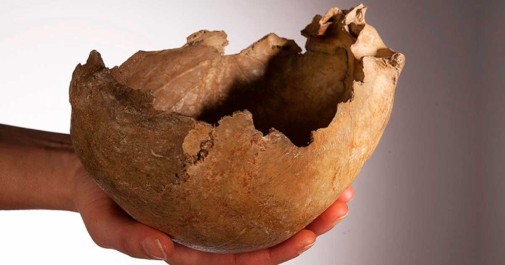Oldest human DNA reveals two populations recolonised post Ice Age Britain
Posted on 24 October 2022
 A skull from Gough’s Cave, Somerset. Image: Natural History Museum
A skull from Gough’s Cave, Somerset. Image: Natural History Museum
The DNA is from individuals that lived more than 13,500 years ago, and indicates the presence of two distinct groups in Britain at the end of the last Ice Age.
Along with other new evidence on their diet and culture, their genetic and cultural diversity is painting a more complex picture of the humans that recolonised Britain at the end of the last Ice Age.
Old Stone Age
Dr Sophy Charlton, lecturer in Bioarchaeology at the University of York, said: “The period we were interested in, from 20-10,000 years ago, is part of the Palaeolithic – the Old Stone Age.
“This is an important time period for the environment in Britain, as there would have been significant climate warming, increases in the amount of forest, and changes in the type of animals available to hunt.
"There are very few human remains of this age in Britain; perhaps around a dozen individuals from six sites. We looked at two of these Palaeolithic individuals – one from Gough’s Cave in Somerset and the other from Kendrick’s Cave in North Wales."
Glaciers
Approximately two-thirds of Britain was covered by glaciers during the Ice Age. Around 17,000 years ago, as the climate warmed and the glaciers were melting, drastic ecological and environmental changes took place and humans began to move back into northern Europe.
For the first time, the study reveals that the recolonisation of Britain consisted of at least two groups with distinct origins. The first group seem to be the same people who created Magdalenian stone tools, a culture known also for iconic cave art and bone artefacts, and were the first group to expand into Northwest Europe around 16,000 years ago.
The second group appeared in northwest Europe around 2,000 years later, and are known as “western hunter-gatherers”. They seem to have their ancestral origins in the Near East. As Britain sits at the extreme northwest corner of the continent, it’s the end of the line for these human migrations.
Culturally different
Dr Selina Brace, researcher at the Natural History Museum, said: "We really wanted to find out more about who these early populations in Britain might have been.
"We knew from our previous work, including the study of Cheddar Man, that western hunter-gatherers were in Britain by around 10,500 years ago, but we didn’t know when they first arrived in Britain, and whether this was the only population that was present."
The study also found that these populations were not just genetically different, but culturally different too. Chemical analyses of the bones showed that the individuals from Kendrick’s Cave ate a lot of marine and freshwater foods, including large marine mammals.
Mortuary practices
Humans at Gough’s Cave, however, showed no evidence of eating marine and freshwater foods, and primarily ate terrestrial herbivores such as red deer, bovids (such as wild cattle called aurochs) and horses.
Their mortuary practices also differed. There were no animal bones showing evidence of being eaten by humans found at Kendrick’s Cave, indicating that the cave was used as a burial site by its occupiers. Animal bones that were found included portable art items such as a decorated horse mandible.
In contrast, animal and human bones found at Gough’s Cave showed significant human modification including human skulls that have been modified into ‘skull-cups’ and have been interpreted as evidence for ritualistic cannibalism.
The study shows that it is possible to obtain useful genetic information from some of the oldest human skeletal material in Britain.
Explore more news

New butterfly species created 200,000 years ago by two species interbreeding
Thursday 18 April 2024

Children in the North at greater risk of entering care
Wednesday 17 April 2024

Boreal forest and tundra regions worst hit over next 500 years of climate change, study shows
Monday 8 April 2024

Researchers developing ultra-sensitive blood test with potential to revolutionise diagnosis of Alzheimer’s
Thursday 4 April 2024

Attitudes to being an adult are shifting as traditional milestones become out of reach, new study finds
Wednesday 27 March 2024
Media enquiries
About this research
The research, in collaboration with University College London and the Francis Crick Institute, is published in Nature Ecology and Evolution.
